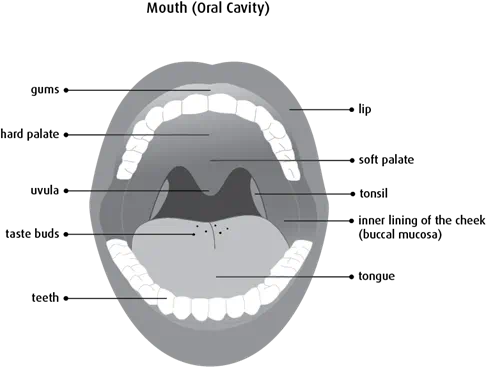What is oral cancer?
Oral cancer starts in the cells of the mouth. A cancerous (malignant) tumour is a group of cancer cells that can grow into and destroy nearby tissue. It can also spread (metastasize) to other parts of the body. The most common place oral cancer spreads to is the lymph nodes in the neck. Oral cancer may also be called oral cavity cancer or mouth cancer.
Cells in the mouth sometimes change and no longer grow or behave normally. These changes may lead to non-cancerous (benign) tumours such as warts and fibromas.
Changes to cells of the mouth can also cause precancerous conditions. This means that the abnormal cells are not yet cancer, but there is a chance that they may become cancer if they aren’t treated. The most common precancerous conditions of the mouth are leukoplakia and erythroplakia.
But in some cases, changes to the cells of the mouth can cause oral cancer. The mouth is covered by a lining called the oral mucosa (mucous membrane). The oral mucosa is made up of squamous cells called the squamous epithelium. Most often, oral cancer starts in these flat, thin squamous cells. This type of cancer is called squamous cell carcinoma of the mouth.
Rare types of oral cancer can also develop. These include salivary gland cancer and melanoma.
The mouth
The mouth (oral cavity) is part of the digestive system. It includes the lips, cheeks, roof of the mouth (called the palate), floor of the mouth and the part of the tongue in the mouth (oral tongue). The structures in the mouth help you speak, taste and chew.


Structure
The mouth begins at the border between the skin and the lips. The roof of the mouth is formed by the hard palate and the soft palate. The mouth leads into the oropharynx (the middle part of the pharynx) and the soft palate separates the mouth from the nasopharynx (the upper part of the pharynx). The inner surface of the cheeks forms the sides of the mouth. The tongue takes up most of the floor of the mouth (the lowest part of the mouth).
The mouth can be divided into specific areas, including:
- the lips
- the soft palate
- the tonsils
- the tongue
- the uvula
- the floor of the mouth
- the inner lining of the cheeks (buccal mucosa)
- the upper jawbone (maxilla) and hard palate (the bony part at the front of the roof of the mouth formed by part of the upper jawbone)
- the gums and alveolar ridge (the ridge-like border of the jaws that contains the sockets of the teeth)
- the teeth
- the lower jawbone (mandible)
Function
The mouth has many jobs. It analyzes food and other materials that are put into it so you can decide if they should or shouldn’t be swallowed. The first step of digesting food happens in the mouth. We use our teeth to chew food. Chemicals in our saliva start to break down starches (carbohydrates). Saliva in the mouth also makes food slippery so it can be swallowed more easily. Taste buds on the tongue tell us what our food tastes like. The tongue and soft palate also move food around in the mouth to help with chewing and swallowing.
The mouth also helps us to:
- speak
- breathe
- drink
- change our facial expressions
- kiss
